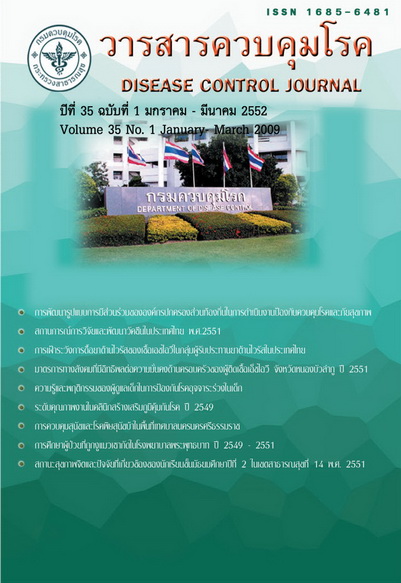Dogs and Rabies Control in Nakhon Srithammarat Municipal Area
Keywords:
Dogs and Rabies Control, Nakhon Srithammarat Municipal AreaAbstract
Rabies is a zoonotic viral disease and serious public health problem, transmitted to humans through a wound (mainly animal bites and scratches). The incubation period varies from 2 weeks to 6 years (average 2 -3 months) depending on the amount of virus and site of inoculation. Dogs is the cause of environmental problems as well as rabies in human. Nakhon Srithammarat Municipal authority has to take responsible on this matter. The objective of this study was to control the dogs in order to control rabies and get rid of annoyance. Licensing of dogs at the early age of 4 months, rabies vaccination, taking photographs or giving ear marked tattoo or microchip implanted were included in the program of which operated from July 2006 to December 2008 (30 months). There were 7,921 dogs licensed, vaccinated, of which 6,113 were owned dogs and 1,788 were stray dogs. It was believed that the control program, by licensing and vaccination should reach at least 80% of dog population in Municipal area, estimated of 10,000 dog population, among which 6,500 were owned dogs, and 3,500 were stray dogs. Sterilization should decrease about 9,000 dog population, more or less. However dog population seemed to be stable due to the excess breeding of owned dogs or some unwanted problems, the owner still moved them out to be strayed. So specific strategies for this problem should not be operated by the government alone, but creating public awareness and acceptance that rabies and environmental problems from dogs were everyone's problem and responsibility should be accompanied.
Downloads
References
2. World Health Organization. Strategies for The Control and Elimination of Rabies in Asia. Geneva, 2001.
3. World Health Organization. Rabies. "WHO recommended standards and strategies for surveillance, prevention and control of communicable diseases".
4. World Health Organization. Rabies vaccines WHO position paper. Weekly epidemiological record.2007; 82: 49/50: 425-436.
5. World Health Organization. Rabies Elimination in South-East Asia. Report of a Workshop Columbo, Sri Lanka, 2005.
6. Puanghat A , Hunsoowan W , Rabies Situation in Thailand J. Med Assoc Thai 2005 ; 88 : 1319 - 1322.
7. World Health Organization. Report of the 3 rd International Symposium on Rabies in Asia. Wuhan, China, 1996.
8. สุเมธ องค์วรรณดี, ประวิทย์ ชุมเกษียร, นราทิพย์ ชุติวงศ์ และ วิโรจน์ ตั้งเจริญเสถียร. ต้นทุน – ผลได้ ของการควบคุมโรคพิษสุนัขบ้าในประเทศไทยโดยเน้นการควบคุมในสุนัข. วารสารวิชาการสาธารณสุข. 2546 ; 12: 6: 937 - 948.
9. นพราชย์ อินทองคำ และ พัชรินทร์ จรจรัส. การลดประชากรสุนัขเพื่อควบคุมโรคพิษสุนัขบ้าในพื้นที่เทศบาลนครนครศรีธรรมราช. วารสารการส่งเสริมสุขภาพ และอนามัยสิ่งแวดล้อม. 2550 ; 30:4:118-125.
10. เทศบาลนครนครศรีธรรมราช. เทศบัญญัติเรื่องการควบคุมการเลี้ยงหรือปล่อยสุนัข พ.ศ. 2549, 2549.
11. Hunsoowan W, Puanghat A. Rabies Control in Thailand J. Med Assoc Thai 2005; 88: 1471-1475.
12. Thepsumethanon V, Wide H, Meslin X F. Six Criteria for Rabies Diagnosis in Living Dogs J. Med Assoc Thai 2005; 88: 419 - 422.
13. Wacharapluesadee S, Hemachudha T. Rabies Diagnosis in Human. J. Med Assoc Thai 2005; 88: 859 - 866.
14. Center for Disease Control and Prevention. Human Rabies Prevention - United States, 2008: Recommendations of the Advisory Committee on Immunization Practices. Morbidity and Mortality Weekly Report. 2008; 57: 1 - 28.
15. World Health Organization. Rabies and Envenomings: A Neglected Public Health Issue. Geneva, 2007.
16. Tepsumethanon V, Wilde H, Hemachudha T. Paradigm Shift in Rabies Control: A System Approach. J. Med Assoc Thai 2004; 87: 1530 - 1538.
17. Beaver B V, Baker M D, Gloster R C et al. A community approach to dog bite prevention. JAVMA.2001; 218:11:1732 - 1749.
18. Hemachudha T, Rabies and dog population control in Thailand: Success or Failure?. J. Med Assoc Thai 2005; 88: 120 -123.
19. World Health Organization. Oral Vaccination of Dogs Against Rabies. Geneva, 2007.
20. Estrada R, Vos A, De Leon R, and Mueller T. Field trial with oral vaccination of dogs against rabies in the Philippines. BMC Infectious Diseases. 2001; 23:1:1471-1477.
21. Corn J L, Mendez J R, and Catalan E E. Evaluation of Baits for Delivery of Oral Rabies Vaccine to Dogs in Guatemala. Am. J. Trop. Med. Hyg. 2003; 69:2: 155 -158.
22. Rupprecht C E, Hanlon C A, Blanton J et al. Oral vaccination of dogs with recombinant rabies virus vaccines. Virus Research. 2005; 111:101-105.
23. จันทรา สิงห์ชัย. บทบาทที่เป็นจริงและความคาดหวังในการแก้ปัญหาสุนัขจรจัดของกรุงเทพมหานคร 2545-2546. วารสารสัตวแพทย์ผู้ประกอบการบำบัดโรคสัตว์แห่งประเทศไทย. 2546 ; 16: 21-30.
24. ปิยพร วัฒนาภิรมย์, วิรดา วิริยกิจ, อุมาพร พันธุ์ศิริ, ปิยะนุช ประเสริฐเมฆ และสันนิภา สุรทัตต์. การศึกษาเปรียบเทียบผลการตรวจระดับแอนติบอดี้ต่อโรคพิษสุนัขบ้า โดยวิธี enzyme – linked immunosorbent assay (ELISA) กับวิธีมาตรฐาน Rapid Fluorescent Focus Inhibition Test (RFFIT) ในสุนัขไทย. ประมวลเรื่องการประชุมวิชาการทางสัตวแพทย์และการเลี้ยงสัตว์ ครั้งที่ 33. 2550 : 1-2.
25. อรนาถ วัฒนวงษ์ และ พรพิทักษ์ พันธ์หล้า. การศึกษาระดับภูมิคุ้มกันโรคพิษสุนัขบ้าในสุนัขในพื้นที่ท่องเที่ยว เกาะช้าง จังหวัดตราด ปี 2547. วารสารควบคุมโรค. 2547; 30: 4: 389 - 393.
Downloads
Published
How to Cite
Issue
Section
License
Articles published in the Disease Control Journal are considered as academic work, research or analysis of the personal opinion of the authors, not the opinion of the Thailand Department of Disease Control or editorial team. The authors must be responsible for their articles.






